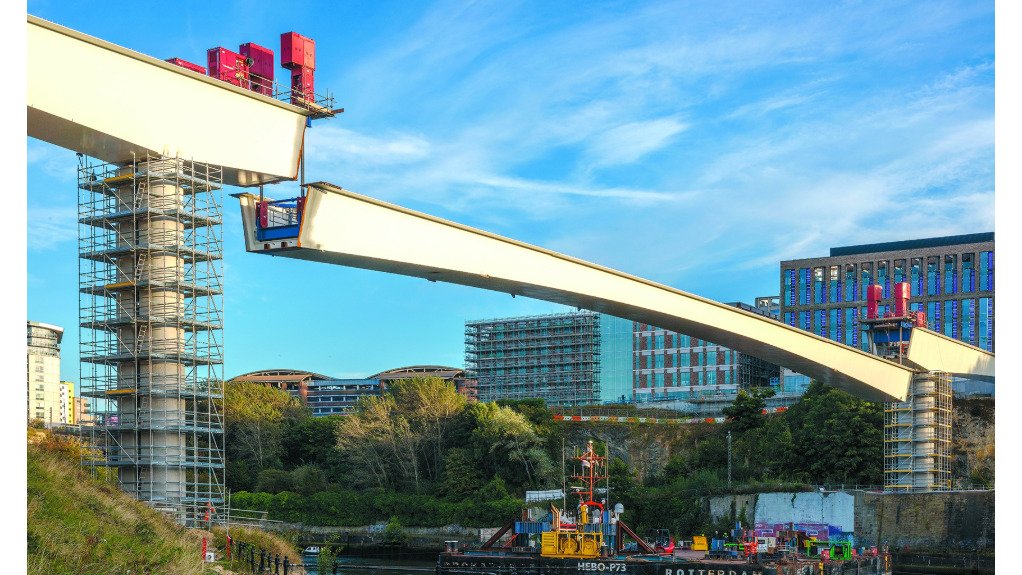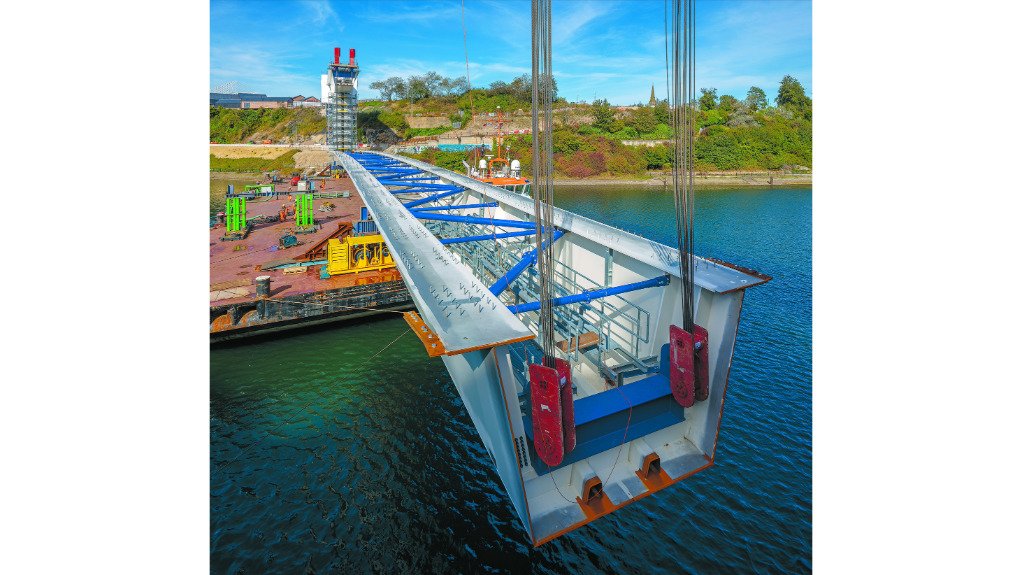Delivery of steel bridge sections completed successfully



RAISING THE BAR The large steel mid-section of the New Wear Footbridge built in Sunderland City being hoisted into position by Mammoet's various solutions
STEELING THE SHOW One of three segments of the 250-m-long steel-concrete composite structure
Heavy lifting transportation service provider Mammoet succeeded in performing the heavy lift and heavy transport of all four New Wear Footbridge steel sections for the project being spearheaded by the Sunderland City Council, in England, in the UK.
The New Wear Footbridge will play a key role in Riverside Sunderland – connecting pedestrian and cyclist traffic from the city centre to the Stadium of Light – home of Sunderland Association Football Club.
Mammoet was faced with the challenge of performing the heavy lifts in a busy city and, to enable its construction in as few modules as possible, simplifying the overall schedule.
As an expert in efficient bridge installation projects and smart site management, Mammoet was appointed to oversee the “smooth delivery” and heavy lifting of the bridge sections.
The 250-m-long steel-concrete composite structure was fabricated by international steel construction company Victor Buyck Steel Construction, in Ghent, Belgium.
Weighing about 1150 t, the bridge comprises four sections that needed to be shipped from Belgium and installed in Sunderland.
Good Timing
Working closely with the Belgium-based marine heavy-lift specialist HEBO, Mammoet arranged for the four bridge sections to be shipped in two voyages spaced a month apart.
This ‘Just-in-Time’ approach allowed enough space for the operations team at Mammoet to install the first two sections and prepare for the arrival of the remaining two.
The team was first mobilised on the north side of the river, ready to receive and lift the first two sections from a barge using an LR 11350 crawler crane.
The first two bridge sections were lifted from the barge onto concrete plinths close to the water’s edge.
The team then dismantled the crane and relocated to the south side of the river, ready to receive the second delivery.
One more bridge section was placed on plinths, and the final, and largest, section – measuring 105 m – was lifted from the barge using strand jacks connected to the previously installed sections.
Strand jacks were necessary as the crawler crane did not have the capacity to perform the heavy lift of the final centre section, which was 300 t heavier than the other parts.
The alternative would have been to erect the bridge in five sections, which would have lengthened the project schedule.
Key Crawler
The crawler crane used on the delivery came directly from another project at the Port of Nigg, in Scotland.
Its parts were transported to Sunderland using 50 conventional trailers, which caused a challenge in scheduling.
“During assembly of a crawler crane, you need to bring in each section as you would build it,” explains Mammoet project manager Richard Gatenby.
He adds that Mammoet needed to make sure that, as the crane was coming from Nigg, the trailers were also arriving in the right order and there was no breakdown in communication.
“We sent the client our transport schedule and plan, so they were aware of what was moving and when,” he explains.
He points out that there were other challenges that the team overcame during the project, including the fact that, while the barges could be positioned in a general mirroring spot in the middle of the river, owing to changing water levels, there were limited opportunities to move them to the river’s edge.
“This was managed carefully to ensure the waterway was kept as clear as possible,” he comments.
Further, owing to the bridge’s curved bottom, when the sections were placed flat on conventional trailers, their angled tops meant one end sat higher than the other. During the heavy lift, careful jacking was needed to rotate them and get them into the correct position.
Similarly, during the heavy transport of the sections in Belgium, the sections needed to be jacked up at one end to level the height and clear low bridges along canals.
Restrictions on space at the south side of the river also meant that a temporary laydown area, the Port of Sunderland, had to be used – not for the bridge sections, but for the crawler crane.
“When you take the crane apart it is the boom sections that are removed first,” clarifies Gatenby, noting that “as a solution, we remove those, take them to the port and then eventually we can get to the main structure of the crane”.
He adds that the company had taken the boom section to the south side straight away, as there would not be enough room to store everything until the delivery of the main structure.
With space at the site limited, a smart delivery and installation approach was essential to ensure a smooth, safe and efficient operation.
“This project demonstrates how Mammoet’s early involvement can help customers plan for a multitude of heavy-lift challenges – even when site space is a challenge,” concludes Gatenby.
Article Enquiry
Email Article
Save Article
Feedback
To advertise email advertising@creamermedia.co.za or click here
Comments
Announcements
What's On
Subscribe to improve your user experience...
Option 1 (equivalent of R125 a month):
Receive a weekly copy of Creamer Media's Engineering News & Mining Weekly magazine
(print copy for those in South Africa and e-magazine for those outside of South Africa)
Receive daily email newsletters
Access to full search results
Access archive of magazine back copies
Access to Projects in Progress
Access to ONE Research Report of your choice in PDF format
Option 2 (equivalent of R375 a month):
All benefits from Option 1
PLUS
Access to Creamer Media's Research Channel Africa for ALL Research Reports, in PDF format, on various industrial and mining sectors
including Electricity; Water; Energy Transition; Hydrogen; Roads, Rail and Ports; Coal; Gold; Platinum; Battery Metals; etc.
Already a subscriber?
Forgotten your password?
Receive weekly copy of Creamer Media's Engineering News & Mining Weekly magazine (print copy for those in South Africa and e-magazine for those outside of South Africa)
➕
Recieve daily email newsletters
➕
Access to full search results
➕
Access archive of magazine back copies
➕
Access to Projects in Progress
➕
Access to ONE Research Report of your choice in PDF format
RESEARCH CHANNEL AFRICA
R4500 (equivalent of R375 a month)
SUBSCRIBEAll benefits from Option 1
➕
Access to Creamer Media's Research Channel Africa for ALL Research Reports on various industrial and mining sectors, in PDF format, including on:
Electricity
➕
Water
➕
Energy Transition
➕
Hydrogen
➕
Roads, Rail and Ports
➕
Coal
➕
Gold
➕
Platinum
➕
Battery Metals
➕
etc.
Receive all benefits from Option 1 or Option 2 delivered to numerous people at your company
➕
Multiple User names and Passwords for simultaneous log-ins
➕
Intranet integration access to all in your organisation
















